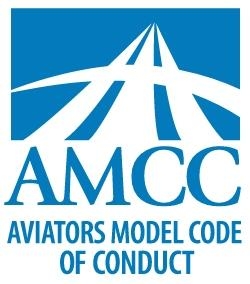Fri, Apr 06, 2012
Code Promotes Ongoing Improvements I Flying Quality And Safety
The Aviators Model Code of Conduct (AMCC)—Version 2.0 was released today by the project’s Permanent Editorial Board. Developed by a team of aviation professionals and drawing upon decades of research and experience, the Code promotes ongoing improvements in flying quality and safety. AMCC Version 2.0 reflects the knowledge and experience gained from extensive research, consultation, and draftsmanship of the many preceding versions.

Pilot conduct impacts the entire aviation community, including its safety culture. John King of the King Schools remarked, “This is a wonderful contribution to the aviation industry. Aviation safety is a matter of ethics. What pilots care about determines how well they manage the risks of flight.” A code of conduct can help any pilot develop a higher level of proficiency. The AMCC is just such a tool, a set of guidelines that is adaptable to each pilot and organizational need.
The AMCC:
- Promotes flight and ground safety, professionalism, and pilot contributions to the aviation community and society at large.
- Encourages the development and adoption of good judgment, ethical behavior, and personal responsibility.
- Supports improved communications between pilots, regulators, and others in the aviation industry.
The Code of Conduct has received extensive industry review and presents a vision of aviation excellence within its seven sections: (1) General Responsibilities of Aviators; (2) Passengers and People on the Surface; (3) Training and Proficiency; (4) Security; (5) Environmental Issues; (6) Use of Technology; and (7)
Advancement and Promotion of Aviation. The Code is a living document and will be periodically updated to reflect changes in standards, practice, and the aviation environment.
The Aviators Model Code of Conduct Version 2.0 is the latest in a family of similar codes including the Aviation Maintenance Technicians Model Code of Conduct, the Flight Instructors Model Code of Conduct, the Glider Aviators Model Code of Conduct, the Light Sport Aviators Model Code of Conduct, the Seaplane Pilots Model Code of Conduct, and the Student Pilots Model Code of Conduct. Developed as a volunteer effort, each is available as a free public service along with supporting materials online.
More News
Witness Reported The Airplane Was Flying Low And Was In A Left Bank When It Struck The Power Line Analysis: The pilot was on final approach to land when the airplane collided with >[...]
How To Get A Story On Aero-TV News/Feature Programming How do I submit a story idea or lead to Aero-TV? If you would like to submit a story idea or lead, please contact Jim Campbel>[...]
From 2012 (YouTube Edition): A Segment Of The Sport Aviation World That Truly Lives "Low And Slow" Pity the life of ANN's Chief videographer, Nathan Cremisino... shoot the most exc>[...]
Aero Linx: International Business Aviation Council (IBAC) IBAC promotes the growth of business aviation, benefiting all sectors of its industry and in all regions of the world. As >[...]
Execute Missed Approach Instructions issued to a pilot making an instrument approach which means continue inbound to the missed approach point and execute the missed approach proce>[...]
 NTSB Final Report: Cozy Cub
NTSB Final Report: Cozy Cub ANN FAQ: Contributing To Aero-TV
ANN FAQ: Contributing To Aero-TV Classic Aero-TV: Seated On The Edge Of Forever -- A PPC's Bird's Eye View
Classic Aero-TV: Seated On The Edge Of Forever -- A PPC's Bird's Eye View ANN's Daily Aero-Linx (04.29.25)
ANN's Daily Aero-Linx (04.29.25) ANN's Daily Aero-Term (04.29.25): Execute Missed Approach
ANN's Daily Aero-Term (04.29.25): Execute Missed Approach



